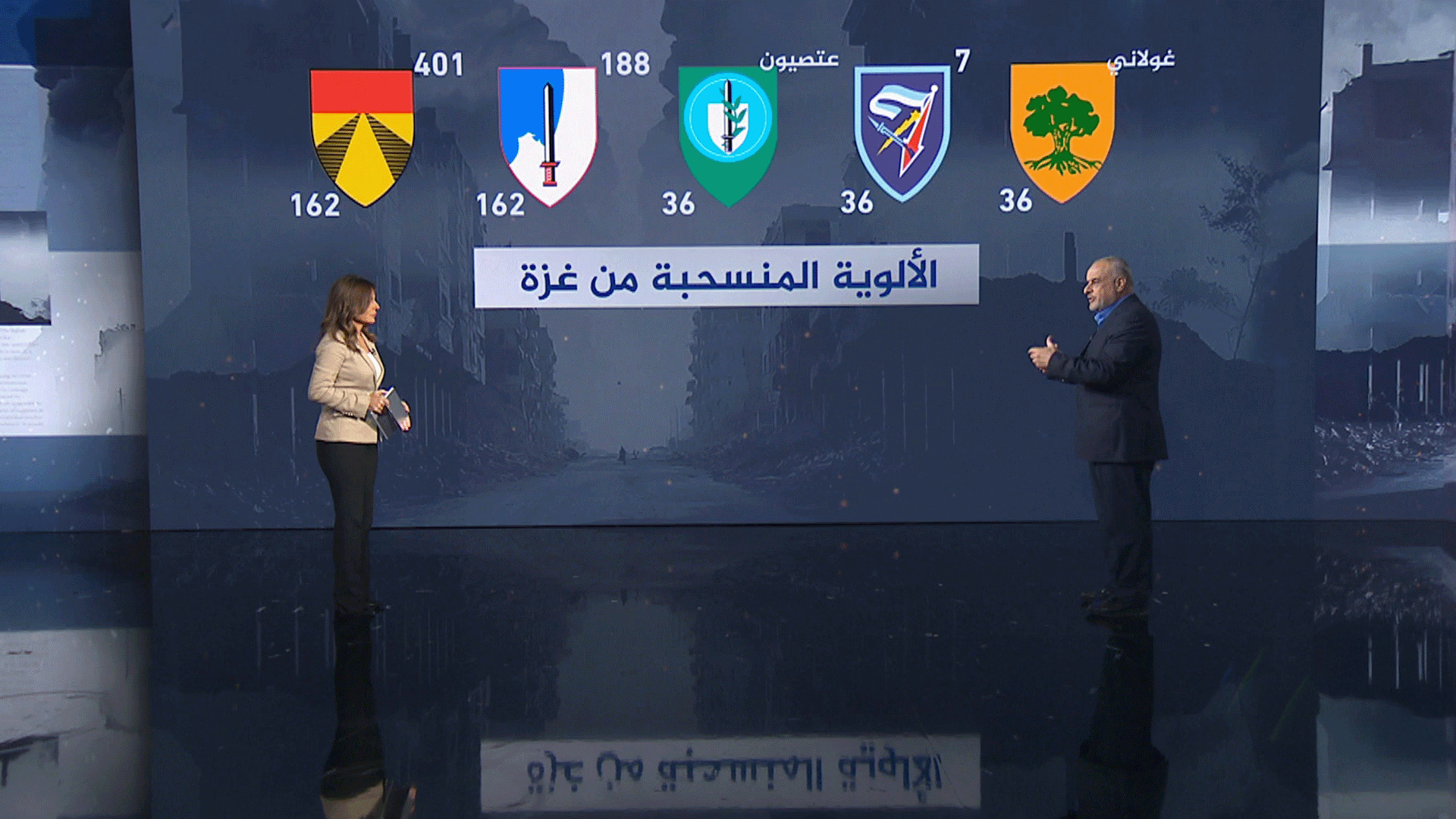Published On 10/10/2025
|
Last update: 22:26 (Mecca time)
The military and strategic expert, Colonel Hatem Karim Al-Falahi, said that the implementation of the ceasefire agreement in Gaza actually began with the Israeli army beginning to withdraw its forces from the areas where they were stationed around Gaza City, noting that 4 Israeli military divisions were surrounding Gaza City and carrying out their operations there.
He explained that these divisions were the 36th Division, which was fighting south of the city, the 162nd Division in the northern regions, and the 98th Division in the north of the Gaza Strip, in addition to the 99th Division, which was stationed in the Netzarim axis, indicating that these heavy divisions, supported by armored and mechanized sectors, began withdrawing to areas that had been previously agreed upon.
Read also
list of 4 itemsend of list
He added that the Israeli army dismantled a large number of fortified points and sites that it had established during its recent operations, especially in the Netzarim axis, indicating that the withdrawal took place from the “Blue Line” towards the “Yellow Line” as part of the redeployment of forces after the disengagement with the resistance factions.
He pointed out that the opening of the main roads, such as Al-Rashid and Salah Al-Din Street, is a clear indication of the gradual return of civilian life, after some sections that were destroyed during the recent battles were rehabilitated, adding that this contributes to facilitating the return of hundreds of thousands of displaced people who have already begun moving north towards Gaza City.
The Ministry of Interior in Gaza announced that security and police personnel began to deploy in the areas from which the occupation withdrew to restore order and secure the movement of civilians, while the Israeli army confirmed that the withdrawal from inside the cities came in implementation of the terms of the agreement sponsored by the United States, Egypt, Qatar and Turkey.
Israeli withdrawal
Al-Falahi stated that the Israeli withdrawal included the removal of most of the combat brigades from the Gaza Strip, explaining that the 36th Division withdrew with all its formations, including the Golani Brigade, the Etzion Brigade, the 7th Armored Brigade, and the 188th Brigade. The 401st Armored Brigade was also withdrawn from the 162nd Division, which is one of its most prominent offensive formations.
He stressed that this withdrawal means a broad repositioning within a new deployment plan, so that specific units are responsible for monitoring sensitive points on the lines of contact, while other units are withdrawn to rest and prepare for any possible field developments during the coming days.
This comes in light of Israeli warnings to residents against approaching some areas that the army described as “extremely dangerous,” while Washington announced through its envoy Steve Witkoff that the Israeli army had completed the first phase of its withdrawal, after which a 72-hour period would begin before the prisoner exchange process was carried out.
Al-Falahi said that the current stage is considered one of the most important stages in the path of the agreement, as it represents the beginning of a comprehensive ceasefire, followed by a partial but not complete gradual withdrawal, in addition to the start of implementing the prisoner exchange deal and the return of the bodies of the dead.
He explained that this process requires the withdrawal of Israeli forces from areas where there are believed to be bodies to allow resistance factions to search for them, noting that a joint committee that includes the United States, Qatar, Egypt, Turkey, and Israel will follow up on these arrangements and supervise their implementation on the ground.
He added that the period specified as 3 days may be sufficient to release living prisoners, but it is not sufficient to complete the process of collecting the bodies scattered in several areas of the Gaza Strip, which may impose a temporary extension of this clause until all field procedures are completed.
Zero point
Al-Falahi believes that the success of the first phase of the agreement depends on the accuracy of the monitoring mechanisms between the two parties, and the extent of commitment to breach controls, noting that any field escalation may return matters to point zero unless clear and joint deterrence mechanisms are agreed upon.
Regarding the subsequent stages, Al-Falahi explained that Israel is focusing on fundamental issues, most notably disarming the Hamas movement and preventing it from participating in the upcoming administrative arrangements for managing the Strip, an issue that the resistance sees as a red line that cannot be conceded.
He pointed out that the plan also includes the formation of an international force that includes Arab units operating under the umbrella of a UN resolution to ensure the stability of the situation, stressing that the implementation of such a proposal requires mutual approval from both sides and precise understandings about the nature of the work of these forces.
Al-Falahi believed that US President Donald Trump’s expected visit to the region next week will be decisive in consolidating the agreement, especially since American and international pressure was the most prominent factor in pushing Netanyahu’s government towards accepting the truce.
He considered that continued international support, especially from important countries such as Qatar, Turkey, Egypt and Pakistan, represents the real guarantee that the agreement will not collapse and that its subsequent stages will be completed.

